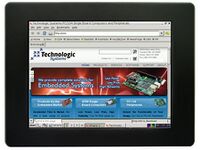TS-8900-4700
 | |
| Released Mar. 2011 | |
| Product Page | |
| Documentation | |
|---|---|
| Schematic | |
| Board Mechanical Drawing | |
| Mounting Mechanical Drawing |
Overview
The TS-TPC-8900 is a complete touch panel computer solution comprised of a 10" TFT LCD, TS-8900 baseboard and a choice of macrocontroller CPUs. It is an ideal solution for applications requiring a touch screen human machine interface (HMI), such as industrial automation, home automation, self-service machines, and point-of-sale terminals. This product offers an excellent value with a full range of features and industry standard connectors and a fanless, low power, high performance modular design. TS-TPC-8900 also provides an upgrade path for Technologic Systems' customers currently using TS-TPC-7390, TS-TPC-7395, and TS-TPC-8390 products.
TS-4700
See the TS-4700 page for functionality regarding the CPU, FPGA, and OS.

|
Marvell PXA166 800MHz ARM9 |
Getting Started
The TS-8900 board has no specific boot sequence since the processor and Linux Operating System are located on the selected TS-4000 Series Macrocontroller. For the rest of the boot and setup procedure, please refer to the manual for the selected TS-4000 series Macrocontroller you are using listed here.
Before attempting to apply power to the TS-8900, perform the following steps while taking proper static discharge precautions
- Place the TS-8900 base board on a firm non-conductive surface
- Alternatively on the provided stand.
- Carefully, insert the TS-4000 Series Macrocontroller daughterboard by aligning and pressing evenly and firmly onto the pair of mating connectors
- Connect the RC-DB9 to the 10 pin CONSOLE header lining up the red wire to the white dot on the board.
- Connect the Ethernet cable if applicable.
- Apply 5-28V of power to the two power pins. Please note the polarity printed on the board.
- Alternatively, you can use POE to power the board. Use only the RJ45 port closest to the macrocontroller for POE.
- Monitor the TS-SOCKET SBC using a terminal emulator connected to the serial console port to verify that the board is operating properly
See the TS-4700 page for more details on dealing with the functionality of the macrocontroller.
Features
Temperature Sensor
See the ts4700ctl for usage and sources for interacting with the temperature sensor onboard the TS-4700. For the TS-8200 temperature sensor you will need to communicate over I2C.
This example shows reading the TS-8900 sensor:
# Only needed in debian
source /initrd/ts4700.subr
gettemp
Connectors
Console
 The 10 pin Console port on the TS-8900 board brings out RS232. Using a RC-DB9 cable you can connect a standard null modem cable to your workstation for development and debugging.
The 10 pin Console port on the TS-8900 board brings out RS232. Using a RC-DB9 cable you can connect a standard null modem cable to your workstation for development and debugging.
| Pin | Name |
|---|---|
| 1 | Not Connected |
| 2 | CONSOLE_RXD |
| 3 | CONSOLE_TXD |
| 4 | CAN2_H |
| 5 | GND |
| 6 | Not Connected |
| 7 | Not Connected |
| 8 | Not Connected |
| 9 | CAN2_L |
| 10 | Not Connected |
| Note: | CAN2 is only available on the 8K LUT FPGA version of the TS-4700. |
Dual USB Header
This is brought out as a USB 2.0 host.
| Header PIN | TS-Socket Location | Name |
|---|---|---|
| 1 | N/A | USB_5V |
| 2 | CN2 29 | HOSTA_USB_M |
| 3 | CN2 31 | HOSTA_USB_P |
| 4 | N/A | GND |
Product Notes
FCC Advisory
This equipment generates, uses, and can radiate radio frequency energy and if not installed and used properly (that is, in strict accordance with the manufacturer's instructions), may cause interference to radio and television reception. It has been type tested and found to comply with the limits for a Class A digital device in accordance with the specifications in Part 15 of FCC Rules, which are designed to provide reasonable protection against such interference when operated in a commercial environment. Operation of this equipment in a residential area is likely to cause interference, in which case the owner will be required to correct the interference at his own expense.
If this equipment does cause interference, which can be determined by turning the unit on and off, the user is encouraged to try the following measures to correct the interference:
Reorient the receiving antenna. Relocate the unit with respect to the receiver. Plug the unit into a different outlet so that the unit and receiver are on different branch circuits. Ensure that mounting screws and connector attachment screws are tightly secured. Ensure that good quality, shielded, and grounded cables are used for all data communications. If necessary, the user should consult the dealer or an experienced radio/television technician for additional suggestions. The following booklets prepared by the Federal Communications Commission (FCC) may also prove helpful:
How to Identify and Resolve Radio-TV Interference Problems (Stock No. 004-000-000345-4) Interface Handbook (Stock No. 004-000-004505-7) These booklets may be purchased from the Superintendent of Documents, U.S. Government Printing Office, Washington, DC 20402.
Limited Warranty
See our Terms and Conditions for more details.